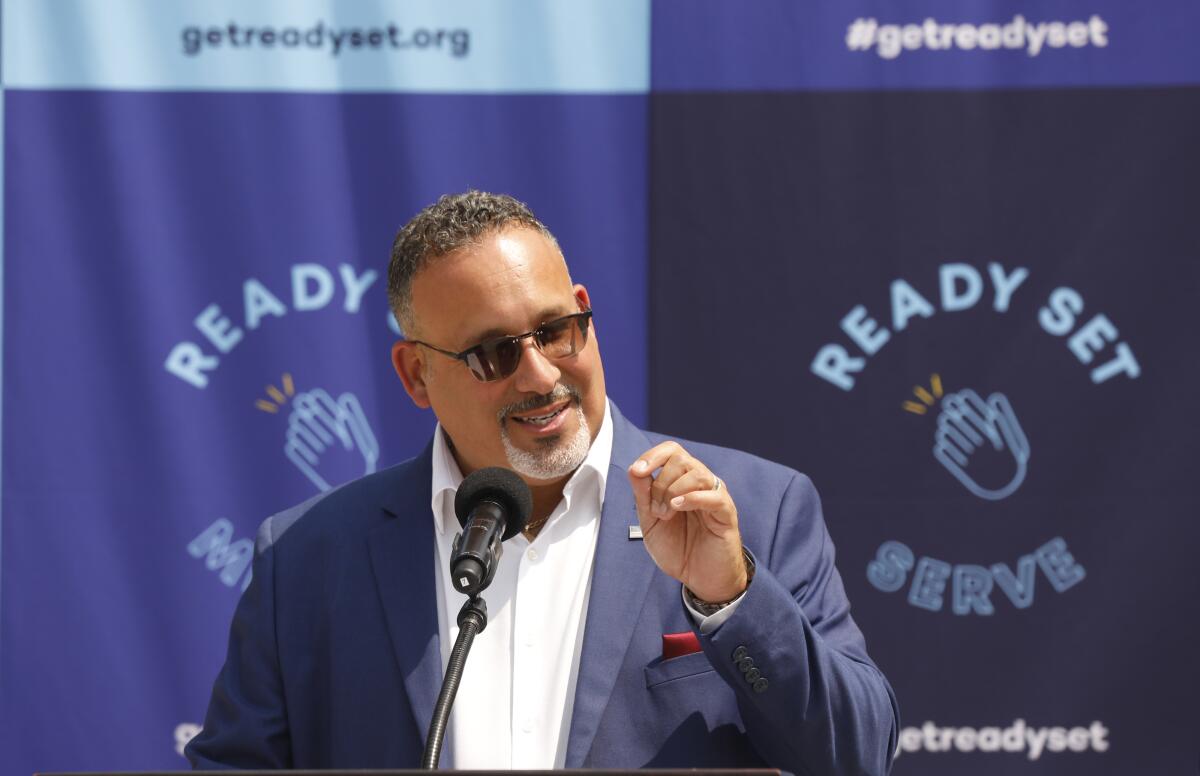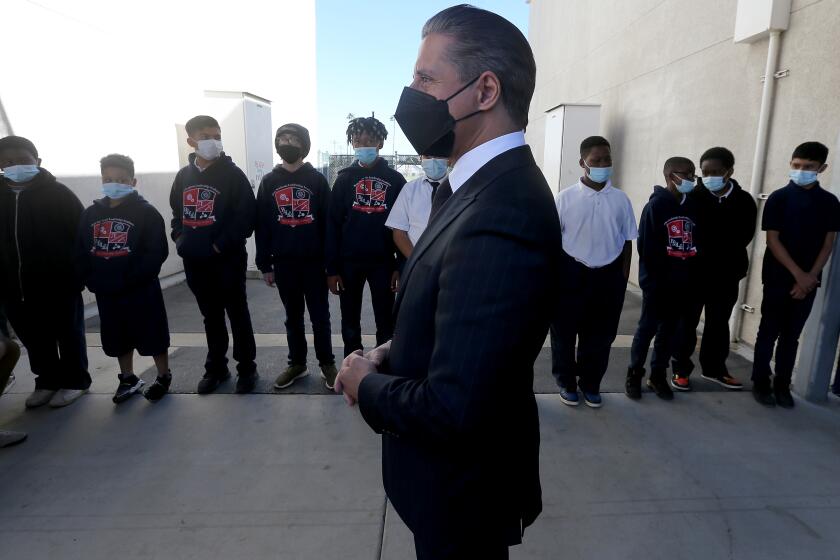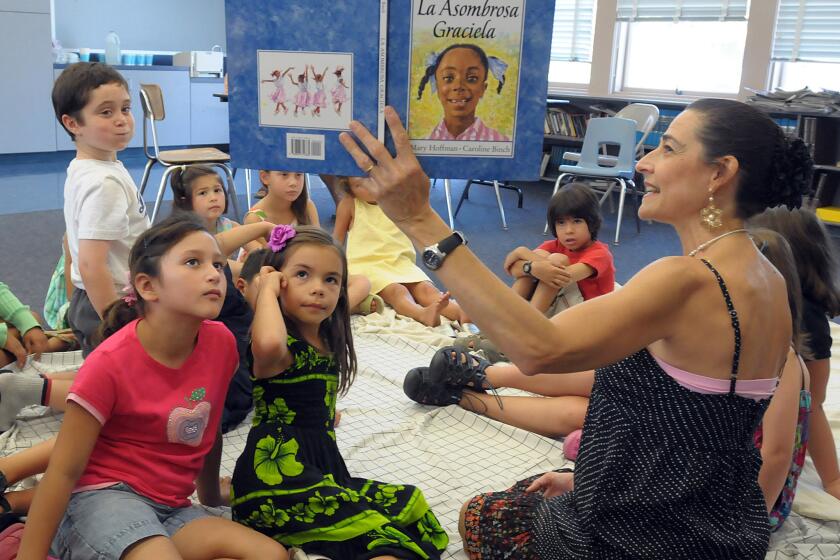Commentary: Being multilingual is no longer a liability for students. That’s good for the U.S.

- Share via
The Netflix show “Emily in Paris” portrays a young Midwesterner struggling to adapt to a new culture after a serendipitous promotion sends her to France. She got the job despite not speaking French, a highly unlikely scenario in real life.
The plot might have been more believable to me if the character were multilingual because I speak English, Spanish and French. Speaking and writing a second language are skills that U.S. Education Secretary Miguel Cardona frequently touts as a superpower that can beget success in an increasingly global workforce. Encouraging students to become multilingual is one of his six focus areas, and he is pushing an initiative to transform the U.S. education system.
Such a national focus on boosting bilingualism is unusual, considering that 78% of U.S. residents speak only English. But it would mean finally encouraging millions of students whose first language is not English to retain their fluency while learning English. It would also emphasize the idea that native English speakers can expand career opportunities by learning a second language. However, it also would require making some radical changes in both attitudes and curriculum if the dream of churning out more bilingual students is to become a reality.
“We must evolve our schools,” Cardona said during a press call earlier this month, adding that the White House is proposing about $125 million in the upcoming budget to support bilingual programs that include expanding the pipeline for language teachers and grants to states for more foreign language instruction.
More than 10,000 kids aren’t enrolling in L.A. Unified schools who should be. The keys to getting them back might work for many more students as well.
These funding commitments are a good start for ambitious proposals that are quite a departure from what we’ve seen from past Education secretaries. It’s taken educators far too long to see the benefits of multilingualism when so many U.S. students speak a second language at home that could be formally taught in conjunction with English for full proficiency in both languages.
Cardona’s tone is also strikingly different from that of educational leaders in the recent past. For decades, students whose first language isn’t English have been viewed as a liability, and were discouraged from using any language but English in the classroom. Nativists decried bilingual education as watering down of U.S. culture.
Such sentiments prompted the passage of Proposition 227 in California in 1998, eliminating bilingual education and requiring public schools to teach students whose first language is not English in English. It was repealed in 2016.
Now, Cardona is asking that we look at these students who speak multiple languages as “gifted with assets.” Such a shift in perspective is long overdue and comes at a time of increasing interest in teaching U.S. students to become proficient in a second language, as shown by the popularity of dual language immersion programs. In 2010, there were about 1,000 dual language programs in U.S. public schools, which grew to more than 3,600 by 2021, according to the American Councils Research Center.
Thanks in large part to dual immersion programs, California leads other states when it comes to foreign language instruction, with more than 57,500 students considered literate in at least two languages in the 2021-22 school year. The state Department of Education has set a goal of enrolling half of K-12 students in programs to become proficient in two or more languages by 2030 and 75% by 2040.
Cardona wants the nation to go much further: to the point where every K-12 student is expected to become literate in a second language.
It’s not surprising that Cardona, whose first language is Spanish, raves about the benefits of bilingualism. He says it helped propel him to become Connecticut’s youngest school principal, and, years later, to his current post overseeing the U.S. education system. It wasn’t easy. Cardona’s Puerto Rican parents spoke their native language at home and he struggled to learn English as a kindergartner.
Ricardo Lara was in college when California voters approved a law that required public school students to speak and learn only in English.
Undoubtedly, the biggest obstacle in helping more students achieve proficiency in a second language is the lack of bilingual teachers, who are considered foreign language instructors and typically must earn bilingual certification. Forty-four states could not fill all their foreign language teacher vacancies, a 2017 study commissioned by Congress found. Schools nationwide have struggled to fill vacancies in recent years, especially those for foreign language teachers.
Under the Global California 2030 initiative, the state has a goal to hire about 2,000 additional credentialed bilingual language teachers by 2029, which would mean about double what it had in 2019. In addition, the state Department of Education is looking at increasing partnerships with programs such as the Migrant Education Mini-Corps Program to expand the pipeline of bilingual teachers.
Clearly, it will take years to create and staff bilingual programs in every public school. But multiplying the number of multilingual students as Cardona envisions will take more than just a shift in public view about the benefits of bilingualism.
The U.S. is one of the few countries considered monolingual, in comparison with most European countries where students begin learning a second language by the age of 9, according to the Pew Research Center. In 2017, the U.S. Department of Defense sponsored the National K-12 Foreign Language Enrollment Survey to determine the state of foreign language instruction in K-12 public schools. It found that only 11 states required foreign language study to graduate.
The fact that most Americans speak only English puts our country at an economic disadvantage and threatens national security if we cannot understand and analyze potential threats such as terrorism or contagions. A lack of multilingual speakers in the U.S. has prompted the Department of Defense to partner with eight states to develop bilingual instruction programs. Certainly, English-only speakers cannot expect to obtain jobs like the one that took Netflix’s Emily to Paris if they don’t have the necessary language skills. That’s a fantasy that exists only in Hollywood.
More to Read
A cure for the common opinion
Get thought-provoking perspectives with our weekly newsletter.
You may occasionally receive promotional content from the Los Angeles Times.













